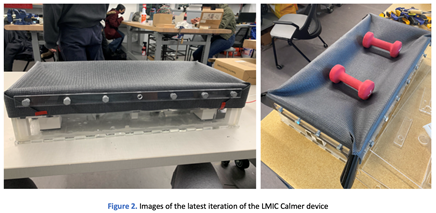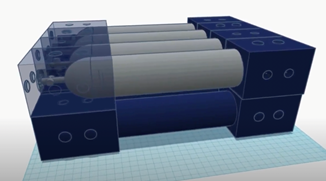Congratulations to our 2022 Design Competition Winners!
Last week, Engineering World Health celebrated the accomplishments of our 2022 college and high school Design Competition winners at Engage, our inaugural virtual awards ceremony.
The EWH college Design Competition, which is open to EWH Chapter members, invites university students to submit innovative designs for medical technology that can make a difference in low-resource settings. Design teams can choose to work on any project relevant to the medical innovations for low-resource healthcare. Our 12th annual competition received 14 fantastic proposals from 10 universities in four different countries.

 After a difficult deliberation process, we are excited to congratulate Cornell University on being named the 2022 EWH Design Competition winner with their LMIC Calmer Device for managing pain in infants in the neonatal intensive care unit. The award was accepted at Engage by Daniel Vitenson on behalf of the Cornell Chapter, which worked with Dr. Liisa Holsti to create a durable, low-cost version of her Calmer device, a complex medical instrument that simulates aspects of the Kangaroo Mother Care technique to manage premature infants’ pain in the NICU. Clinical trials have found that the Calmer device provides the same level of pain management for premature infants as another human touch strategy called facilitated tucking by replicating a heartbeat sound, using a skin-like surface, and mimicking a breathing motion. The current patented Calmer device costs around $50,000, whereas the latest iteration of the LMIC Calmer can be produced for under $300, making this technology much more accessible for healthcare providers in low- and middle- income countries.
After a difficult deliberation process, we are excited to congratulate Cornell University on being named the 2022 EWH Design Competition winner with their LMIC Calmer Device for managing pain in infants in the neonatal intensive care unit. The award was accepted at Engage by Daniel Vitenson on behalf of the Cornell Chapter, which worked with Dr. Liisa Holsti to create a durable, low-cost version of her Calmer device, a complex medical instrument that simulates aspects of the Kangaroo Mother Care technique to manage premature infants’ pain in the NICU. Clinical trials have found that the Calmer device provides the same level of pain management for premature infants as another human touch strategy called facilitated tucking by replicating a heartbeat sound, using a skin-like surface, and mimicking a breathing motion. The current patented Calmer device costs around $50,000, whereas the latest iteration of the LMIC Calmer can be produced for under $300, making this technology much more accessible for healthcare providers in low- and middle- income countries.
Duke University took second place with the LowCostomy, a durable, low-cost colostomy bag, and University College Dublin took third place with Vit-A-Dapt, a low-cost portable adaptometer. Read more about the Design Competition and view the winning projects here.
In 2022 EWH hosted our first-ever design competition for high school students, modeled on our successful college design competition, open to high school students around the world. During the Vontier Virtual High School Design Competition, students developed solutions to a low-resource healthcare challenge posed by EWH and submitted 3-5 minute videos outlining their ideas.
The Husky Innovate team from Fairmont Preparatory Academy in Anaheim, California took first place with their design for Dual-Cap
 Valve Protection for securing oxygen tanks. The team focused on solving this issue in Uganda, where transportation and storage pose major risks to oxygen tank security and safety. Their design, which includes two cube-shaped caps at the end of each tank, also increases efficiency of transportation, increasing the number of tanks that a truck can safely transport. Each set of caps also features a ball and socket fastening mechanism to fix tanks together, minimizing movement during transport.
Valve Protection for securing oxygen tanks. The team focused on solving this issue in Uganda, where transportation and storage pose major risks to oxygen tank security and safety. Their design, which includes two cube-shaped caps at the end of each tank, also increases efficiency of transportation, increasing the number of tanks that a truck can safely transport. Each set of caps also features a ball and socket fastening mechanism to fix tanks together, minimizing movement during transport.
Anna Beck and Eleanor Lewis from Miami, Florida, took second place with CoolRide, a design for cooling medicine with evaporative and chemical cooling, and the Huskyvation team, also from Fairmont Prep, took third place with their design for a low-cost multi-effect basin still for water distillation in the Dominican Republic.
Andrea Dam, an 11th grade student from the winning Husky Innovate team remarked, "Our experience with this competition proved to be very rewarding. From our shared interest, we built team spirit, comfort, and collaboration with each other. We also enjoyed the challenge, supportive host, and wonderful resources and unique topics that made us feel more connected to the problem."
Engineering World Health would like to thank all of the students who submitted designs, the educators who guided and assisted them, and our generous sponsor, Vontier, for their support!